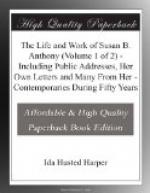The year 1850 was for her one of transition. A new world opened out before her. The Anthony homestead was a favorite meeting place for liberal-spirited men and women. On Sunday especially, when the father could be at home, the house was filled and fifteen or twenty people used to gather around the hospitable board. Susan always superintended these Sunday dinners, and was divided between her anxiety to sustain her reputation as a superior cook and her desire not to lose a word of the conversation in the parlor. Garrison, Pillsbury, Phillips, Channing and other great reformers visited at this home, and many a Sunday the big wagon would be sent to the city for Frederick Douglass and his family to come out and spend the day. Here were gathered many times the Posts, Hallowells, DeGarmos, Willises, Burtises, Kedzies, Fishes, Curtises, Stebbins, Asa Anthonys, all Quakers who had left the society on account of their anti-slavery principles and were leaders in the abolition and woman’s rights movements. Every one of these Sunday meetings was equal to a convention. The leading events of the day were discussed in no uncertain tones. All were Garrisonians and believed in “immediate and unconditional emancipation.” In 1850 the Fugitive Slave Law was passed and all the resources of the federal government were employed for its enforcement. Its provisions exasperated the Abolitionists to the highest degree. The house of Isaac and Amy Post was the rendezvous for runaway slaves, and each of these families that gathered on Sunday at the Anthony farm could have told where might be found at least one station on the “underground railroad.”
Miss Anthony read with deep interest the reports of the woman’s rights convention held at Worcester, Mass., October, 1850, which were published in the New York Tribune.[11] She sympathized fully with the demand for equal rights for women, but was not yet quite convinced that these included the suffrage. This, no doubt, was largely because Quaker men did not vote, thinking it wrong to support a government which believed in war. Even so progressive and public-spirited a man as Daniel Anthony, much as he was interested in all national affairs, never voted until 1860, when he became convinced it was only by force of arms that the question of slavery could be settled.




